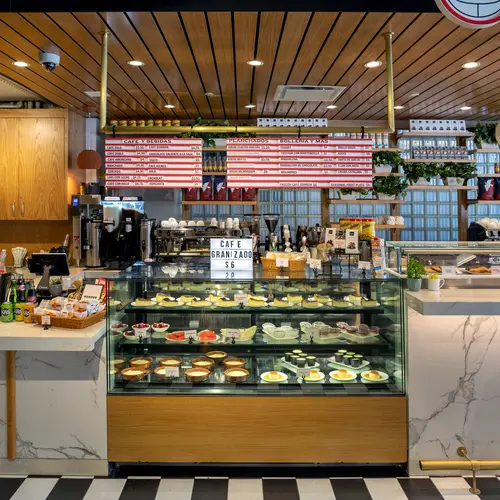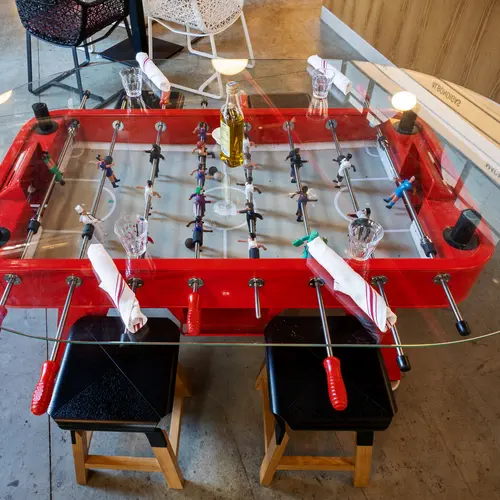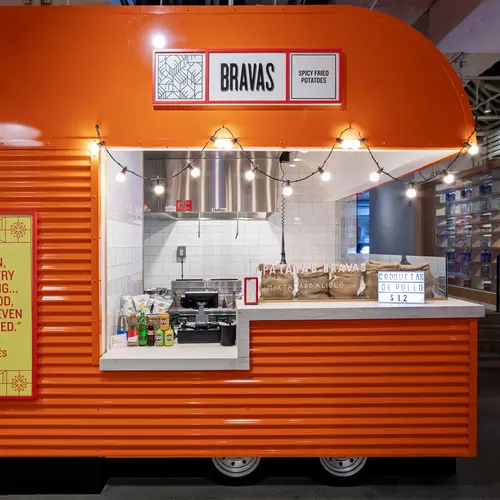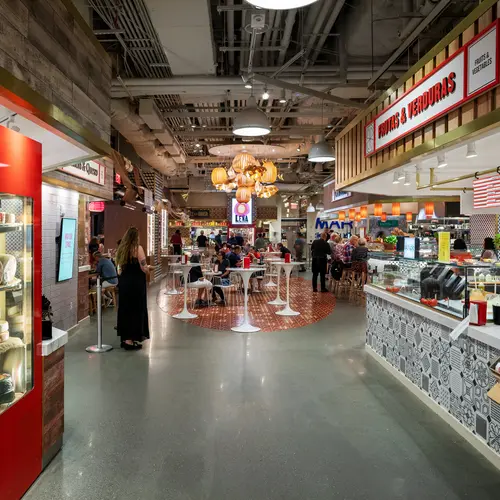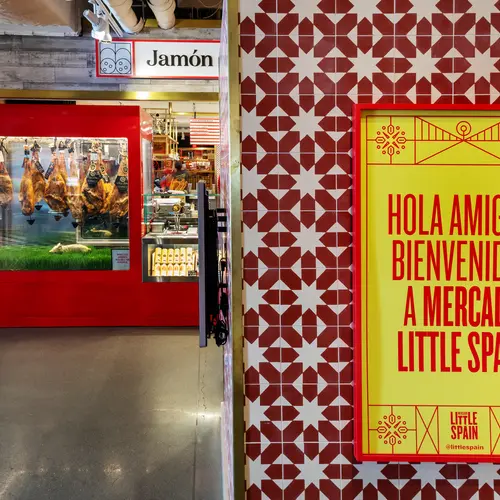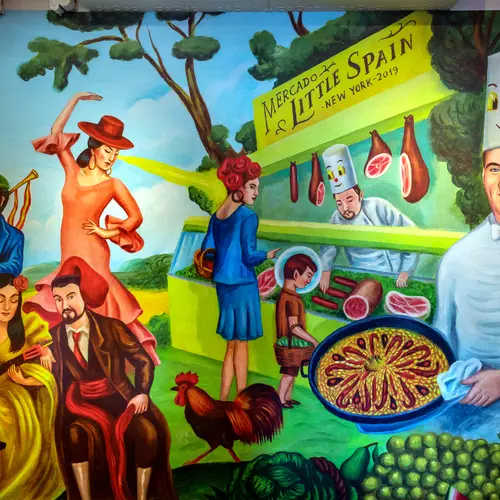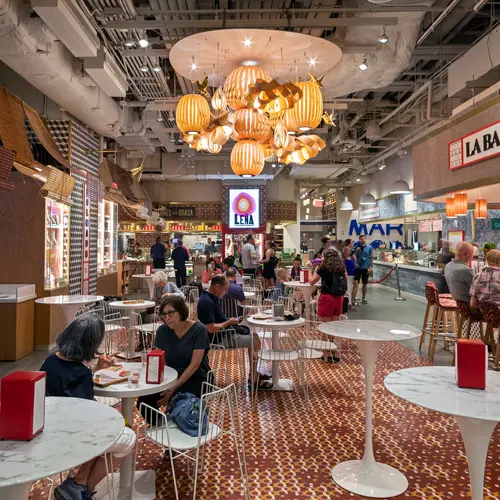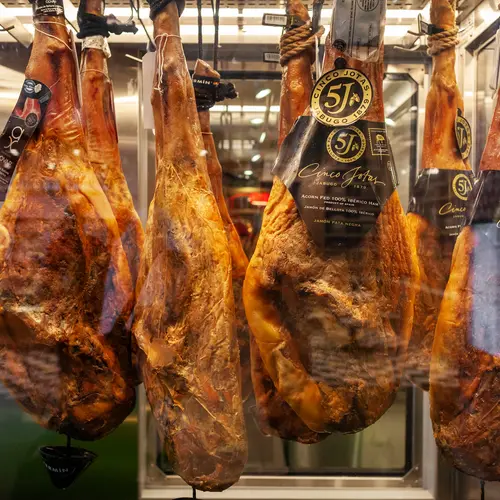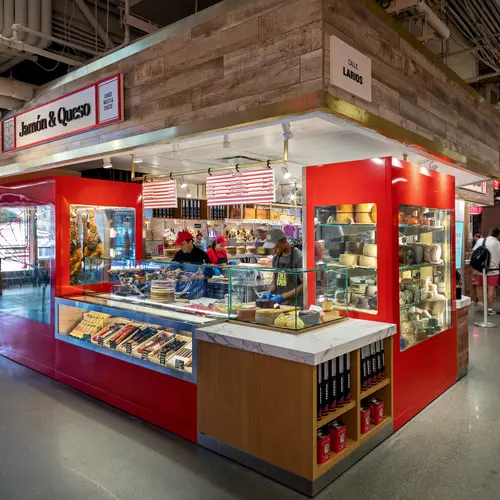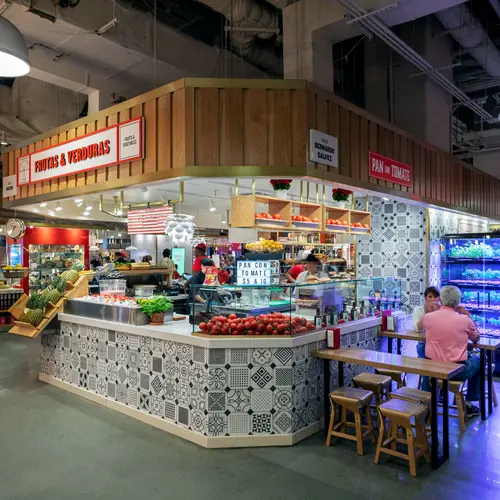The making of Hudson Yards’ Spanish market: Meet the team behind Mercado Little Spain

All photos taken by James and Karla Murray exclusively for 6sqft.
When New York Times food critic Pete Wells visited José Andrés’ Mercado Little Spain, he declared that it had “more great food and drinks per square foot than anywhere else in New York.” From Ibérico hams and Peking duck to the seemingly simple yet ever-pleasing pan con tomate, the food at Hudson Yards’ Spanish market has certainly made its mark on the gastronomy scene. But what sets Andrés apart from other chefs and restauranteurs is his entire vision. Mercado Little Spain is designed as a series of “streets,” with the various kiosks leading guests on a curated experience. Most of the design elements and materials were sourced from Spain, and the artists commissioned represent different regions of the country.
To bring his vision to life, Andrés assembled a stellar team, including Michael Doneff, the Chief Marketing Officer at his ThinkFoodGroup; Juli Capella, co-founder of Spanish architecture and design firm Capella Garcia Architecture; and NYC-based design studio (and NYC food hall experts) ICRAVE. Ahead, take a behind-the-scenes tour of Mercado Little Spain and hear from all these amazing and talented collaborators on what it was like working on the project.

The main entrance at the corner of 10th Avenue and 30th Street, inside 10 Hudson Yards. The garage-style glass doors line the Spanish Diner and are motorized to open up on nice days.
Michael-Doneff, Chief Marketing Officer, ThinkFoodGroup
What makes working with José Andrés so special?
He’s just the real deal. He’s a nice, warm, engaging person, and caring. So that’s the core of who he is. And then he’s super creative…whether it’s food on the plate, or a look for a restaurant, or a logo. And a lot of it is inspired by people he comes across or an artist he’ll find.
What about his philanthropic work?
He told me one Friday he was going to go down to Puerto Rico on Sunday because Maria had just landed. And I said, “Okay.” And then he was down there for two months. He just hit the ground and figured out what he could do in his way, and found friends, and tweeted, and just reached out. He hates planning. He’s not a guy who sits in a meeting and wants to look at a spreadsheet; he’s a doer, and I respect that. It’s really inspiring to work for someone who sees the power in how to change the world, even in a seemingly small way, but one that can turn into a big way. He doesn’t even think about where it’s going. He just knows that he can’t sit back and look at an issue and not try to help fix it.

There are 15 food and beverage stalls within the market, along with three restaurants in the 37,000-square-foot space.
Speaking of being a doer, where did the concept for Mercado Little Spain come from?
Mercados have been part of Spanish culture for centuries. José spent a lot of his formative years in Barcelona, where there are some very famous mercados. It’s part of the fabric of Spanish life. I think he’s always had this idea of creating this neighborhood concept. Not only one Spanish restaurant, but a gathering place where it’s like a party, and you can feature so many different facets of Spain. Spain is such a rich, diverse country, in terms of culture, but also cuisine. There are so many different pockets and so many specialties. So this has been our chance to focus on so many of them, from very casual and something you’d buy on the street, like a churro or patatas bravas, to very elegant seafood dishes. So I think it’s always been in the back of his mind, and when this opportunity came up at Hudson Yards, it was at the right time. We couldn’t pass up an opportunity to be part of such a big, iconic development in the heart of Manhattan.

How did you go about assembling the design team?
José has worked with Juli Capella of Capella Garcia a lot, and he’s very good at channeling José’s creativity. José’s all about trust with people, and it saves a lot of time when someone gets you, and I think that’s what happens with Juli. Juli’s done everything from a Spanish concept to Minibar to Beefsteak, which is a casual vegetable concept, to Fish, which is in the Bahamas. So he’s done things outside Spain, but Juli hasn’t really worked on such a big, wide-ranging concept in the US before. So that’s where ICRAVE came in. We knew that we needed a partner for him that could really compliment Juli’s creativity. Juli acted as the soul of Spain, but ICRAVE helped us execute that vision and make it happen in a big, very complicated development in New York City with a ton of moving parts.


How important was it to keep the Spanish authenticity?
We wanted to make everything about Spain and not only showcase food and wine, but the design, art, manufacturers, and artisans. So every tile, most every surface, every light fixture, almost every chair, a lot of art and murals–everything’s made in Spain and designed by Spaniards. The overall branding was done by a Spanish firm, and three regional artists designed the logos for the three restaurants.
Could you see Mercado Little Spains popping up elsewhere in the country?
We’re definitely going to look at other locations. We’ve already had some inquiries. I think we want to get this one right, and we’re learning every day as we see how people use it. So before we get too deep into another version or another location, we want to make sure we’ve got this one nailed down. But we’re definitely interested in opening in other gateway cities in the US. I think there’s an appetite for it.
Juli Capella, Co-Founder, Capella Garcia Architecture
What is unique about working with José Andrés?
José is not just a cook. He is a unique character, he is a hyperactive, creative, a chaotic multidisciplinary, a torrent of energy. And he also cooks very well. You must follow his intuitions, try to surprise him, constantly reinvent. Working with José requires a high degree of commitment. You can never let your guard down. It is exciting and fun to work with him, but also very hard!


What were some of the differences working in the U.S. versus Spain?
In New York, everything is bigger, faster, harder, more resistant. We have been surprised by the immense amount of regulations that exist, almost everything is conditioned, restricted, protected, prohibited. It is not that in Spain it is a free party, there are also many regulations that we have complained about, but I will never complain again since now they seem few compared to New York.
We have also been surprised by the great technical capacity of the construction company, its order and cleanliness in the work, the quality of the finishes. Related has a high degree of control and reliability in its projects. Working in the capital of the world has been a privilege.
What did you learn about NYC food halls from ICRAVE?
I am lucky to have worked with ICRAVE, it has been an honor. They are a very cool team and know New York very well. We made a trip to explore all the interesting places, including their projects, and they taught us many things. It was like a concentrated master of knowledge, which helped us to focus Mercado Little Spain from another perspective, more genuinely Spanish.

The mural outside the Spanish Diner is by Sergio Mora and features José Andrés himself
How did you go about choosing an artist for the murals?
José Andrés always likes to use art in his restaurants. Not as decoration, but as part of the content, as a desire to project Spanish art in the USA. He enjoys painting and sculpture and is something of an artist himself. Here we wanted to work with three very different characters, which extend three very powerful Spanish graphic cultures, from different parts of the country. For a long time Mikel Urmeneta of northern Spain, resounding, funny, punk. Sergio Mora, from Barcelona with a personal and dreamlike magical world. and Javier Mariscal who is Valencian, with his childish, energetic, fresh and welcoming stroke. Each one has made his contribution, giving an artistic touch to the whole project.

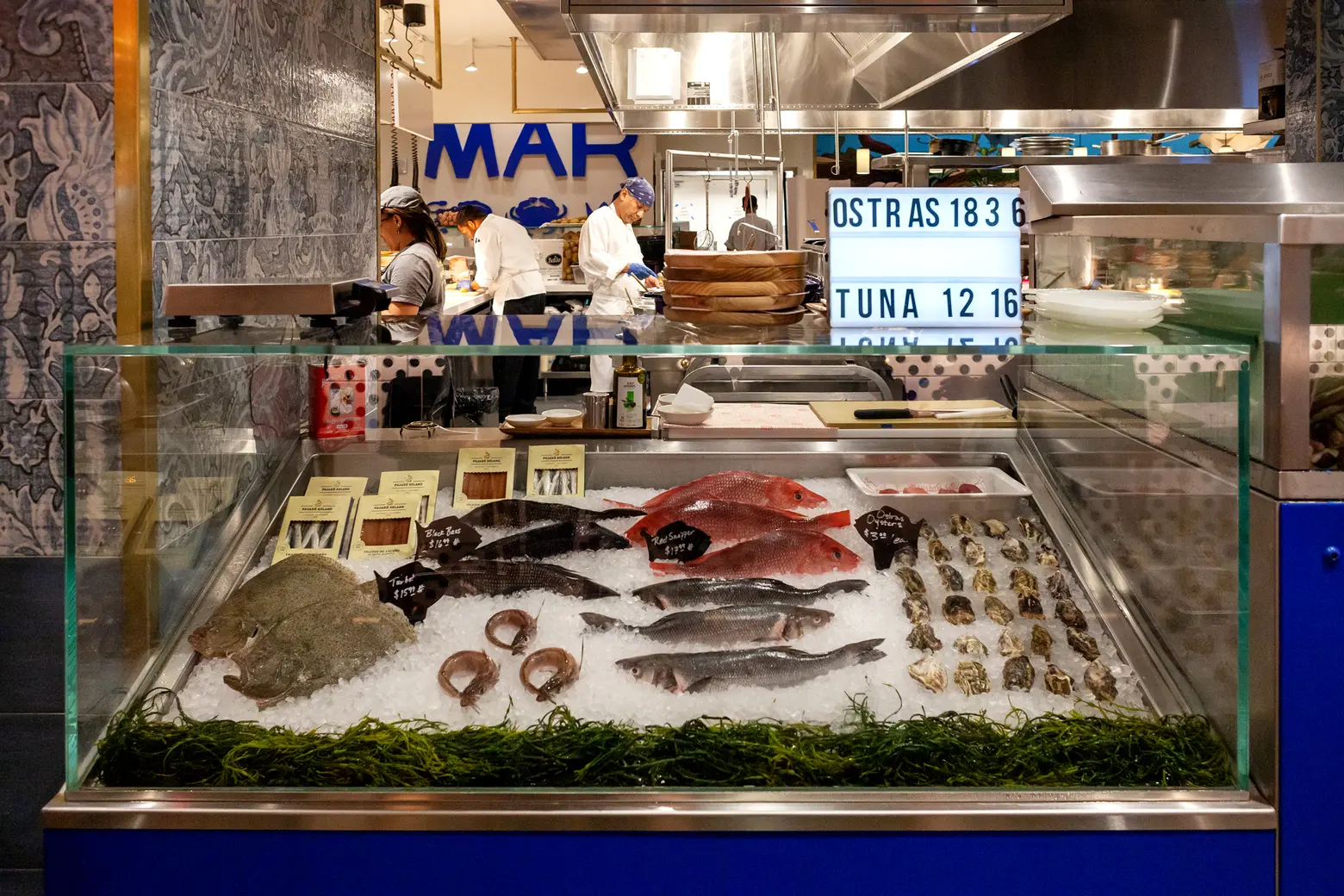
Mar is the seafood restaurant within the market, which sources its fish from Spain.
What was the most challenging aspect of the project?
Knowing how people would circulate. When you make the distribution of a restaurant, it is necessary to know that there is a flow of customers and another of service, which should not be crossed. When you make a market, the same thing happens, but the streets are sized for merchandise. But if what you do, in this case, is a typological invention, a mix between food-court, restaurant and Spanish-style market, it was very difficult to calculate how people would circulate. We had to achieve, on the one hand, comfortable perimeter seating areas, and on the other, clear and fluid corridors. All that fulfilling a certain capacity. That has been the most difficult, and we could only know if it was well sized on the day of the opening. Fortunately, people ran through the streets and the different stalls in an easy way, although losing themselves a little, wandering around, and that was precisely what we wanted.

Do you have one favorite design element?
If I have to choose one, I’d choose the big lamp that crowns the central space, or the Plaza Alta, as we have called it. Because it is beautiful and designed and produced in Spain by the company LZF. I think it is one of the most talented companies in the world, with a catalog of the most poetic lamps. They are clouds, with birds, that give personality and warmth to the space.

What’s your favorite thing to eat at Mercado Little Spain?
I think the paella is excellent and rhymes with Capella. It is authentic; in Mercado Little Spain it is done as it has been done for more than a century in Valencia. And that is an extraordinary fact. Most paellas that are eaten outside of Spain are worthless. And this surpasses even many in Spain. It’s a true delight, thanks to a complex cooking system that allows [cooking over] wood fire with very sophisticated ventilation.
Lionel Ohayon, Founder, ICRAVE; Michelle Schrank, Project Manager, ICRAVE; Renée Joosten, Lighting Director, LICHT/ICRAVE
Why do you think ICRAVE was chosen for this project?
ICRAVE: ICRAVE has specialized experience in the world of New York City food hall design (Mercado Little Spain, Le District, Pennsy, Starrett-Lehigh Market), blending progressive culinary, retail, and cultural experiences into high-energy markets. We’re also well-versed in bringing highly-conceptualized ideas into built reality through technical drawings, construction administration, and troubleshooting along the way.
How did the project compare to other food halls you’ve done?
ICRAVE: Mercado is unapologetically Spanish in every aspect and would never be mistaken for another food hall. The market is a thoroughly authentic showcase of Spanish food, materials, art, culture, humor, and performance and every decision was made with Spain in mind. Even the ambiance and flow of Mercado mirrors the lively energy of Spain’s traditional marketplaces and the energetic, organized chaos typical of a Spanish town.
The other major differentiator is that Jose Andres is a Michelin-star chef delivering Michelin-star food, so we needed to create a machine for a fast-paced but not “fast-food” experience. Each market stall is a mini “chef’s kitchen” where each chef is an expert and the space must perform to the highest culinary standards.
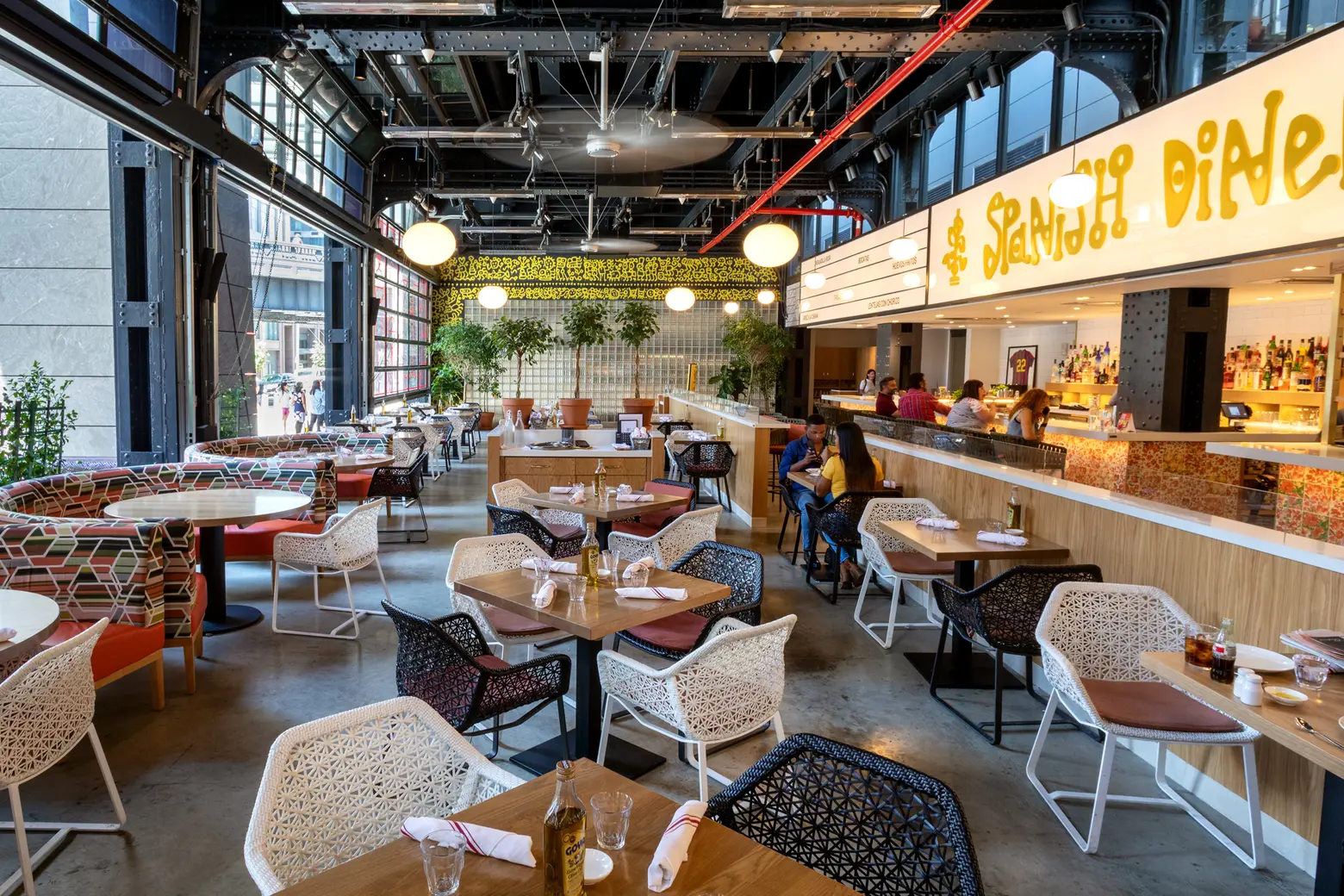
The Spanish diner serves breakfast, lunch, and dinner and is the most casual of the restaurants.
What was the collaboration with Capella Garcia Arquitectura like?
ICRAVE: At the onset of the project, CGA shared an initial 100-page immersion deck with us, filled with colorful imagery of Spanish materials, spirit, and maximalism. The biggest insight into Spanish design was the embrace of chaos, textures, and surrealism that would come to exist in Mercado Little Spain. From there, ICRAVE did further research and analysis on the features, circulation patterns, details, and dimensions that actually define a Spanish market, especially looking at scales of intimacy and aisle proportions to help design a true Spanish streetscape.
With the larger team, there were several multi-day meetings, work sessions, and site visits where the entire team worked through the market operations layout, kitchen design, and overall culinary experience.


There’s a flower market in the front of the Spanish Diner. Two custom-made foosball tables were converted to seating.
Did you take into account the Hudson Yards location?
ICRAVE: Absolutely. There are dozens of ways to traverse around and through Hudson Yards. We wanted to be sure Mercado would become people’s preferred path by giving this foodscape a real sense of place. The goal was to design a food hall that anchors this new emerging neighborhood, acts as an extension of the sidewalk, and creates the street life we have come to expect here in New York. We also wanted to give the retail mall a temporal place where people would feel comfortable coming for breakfast, stopping in from the High Line, coming with friends, and many other instances. With opportunities for discovery, the design can evolve and respond to different user groups that will invariably use it and fall in love with it.
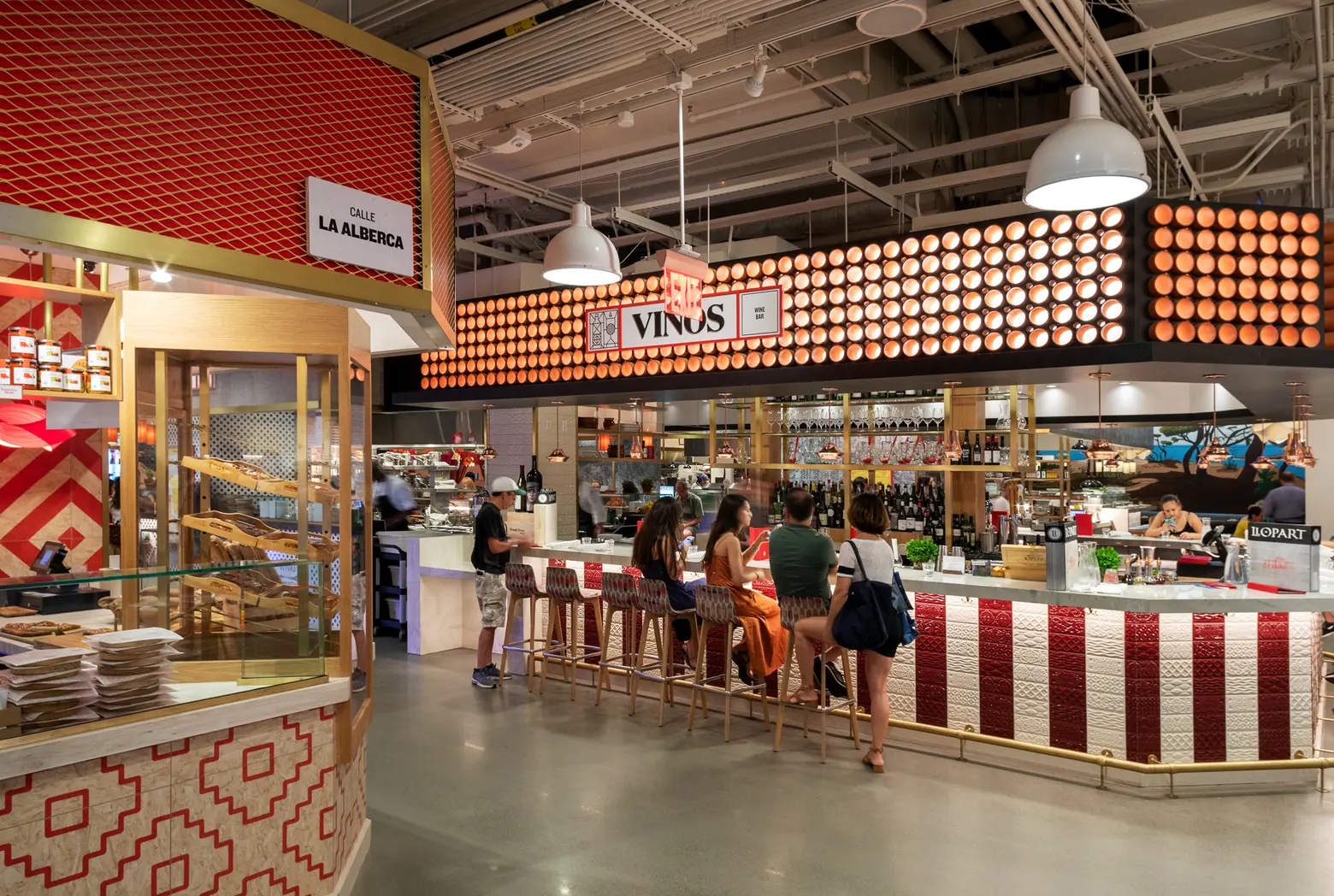
ICRAVE’s in-house lighting team LICHT designed all the lighting. What was that process like?
ICRAVE: The existing space was a challenge from a lighting perspective as the majority of the market is essentially in a “cave” in the underbelly of the 10 Hudson Yards skyscraper, with only a narrow strip of daylight along 30th Street. Lighting was a critical tool to ensure the market felt spacious and comfortable, even without daylight.
We created layers of light to open up the space, emphasizing its three-dimensionality, bringing out the richness of the materials, creating drama, and, most importantly, celebrating the food. Based on mock-ups, we specified high CRI (Color Rendering Index) fixtures to highlight the food’s freshness, diversity, and colors.
The lighting strategy also helped to solve design problems. For example, there are decorative pendants over each POS station as a spatial wayfinding tactic to help guests identify those spots without needed additional signage. Also, the suspended pendants above the market “streets” create a datum that stops your eye from seeing the less attractive ductwork and utility lines above, creating a more intimate environment.
The final challenge of the project is that Mercado Little Spain is open for almost 24 hours of the day, from when the kitchen staff begins prepping in the morning to when the last carafe of sangria is sold in the early morning hours. To help transition from morning to daytime to nighttime lighting in a basically non-daylit space, we specified KETRA tunable light fixtures that not only change in intensity but also in color temperature. This allowed us to create a brighter and crisper environment during breakfast and lunch, while slowly transitioning to a more dimmed and warmer tint of light during late-night dining.

What was the most challenging aspect of the project?
ICRAVE: Getting the overall layout right. The key to a successful market is locating the right program in the right place. At Mercado, the entire space is centered around the plaza and La Barra / Vino bar right in the middle, the restaurants (anchors) around the perimeter of the market, the iconic and photogenic Spanish desserts as you come down the escalator from the retail concourse; and the Granja (coffee) bar along the 30th Street storefront for busy office workers. Making sure that guests can always get a drink to go with their food, and vice versa, is essential to a successful operational model and a true hospitality experience.

Do you have one favorite design element?
ICRAVE: Spanish Diner and the lightbox canopy menu board because it is a little nod to a New York City streetscape.


What’s your favorite thing to eat at Mercado Little Spain?
ICRAVE: It’s so simple but pan con tomate hits the spot every time!
+++
All photos taken by James and Karla Murray exclusively for 6sqft. Photos are not to be reproduced without written permission from 6sqft.





